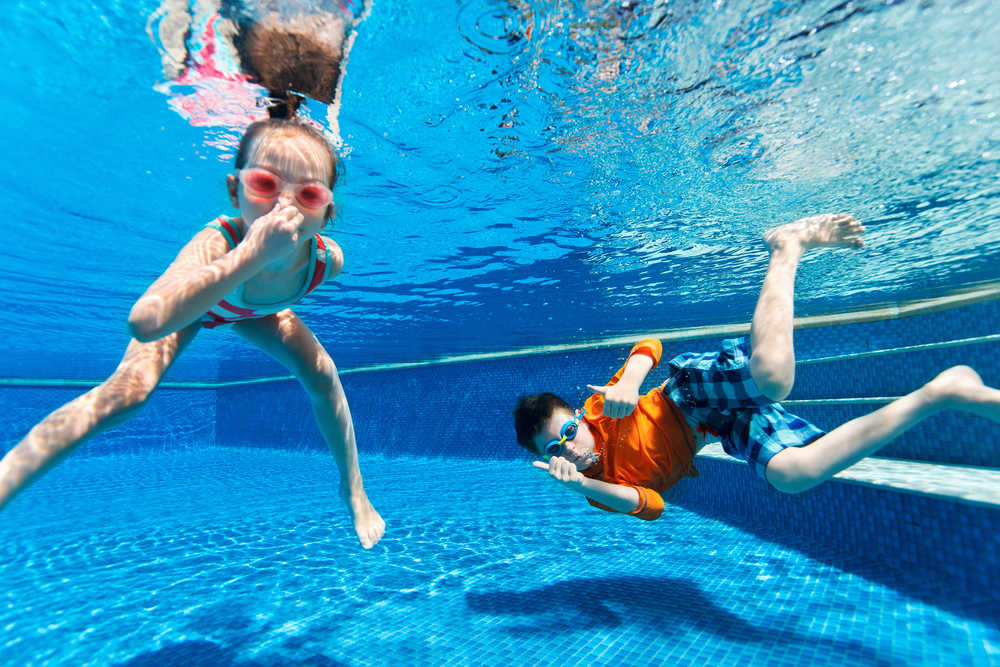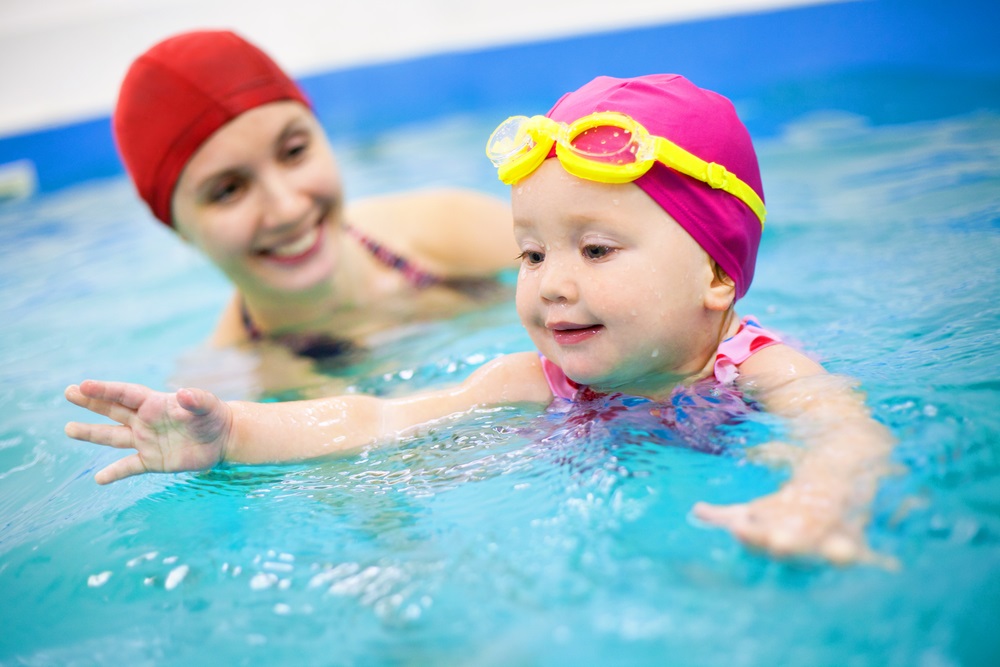Even if your children know how to swim, you can still never leave them unattended in the swimming pool — not even for a second. Knowing how to swim and being unafraid of the water, though will bring more joy to the entire family for a lifetime.
Teach Your Child To Swim
Even if you decide to sign your child up for swim lessons here are a few steps you can take to teach your child to swim in the comfort of your own family swimming pool.
Show your child that water is fun and that they have nothing to fear. You’ve probably heard the stories of how “back in the day” your parents were “taught to swim” when their parents simply dropped them into the water. It was a matter of sink or swim and some parents learned to swim, some sank and were rescued by their parents and still others grew so fearful of the water that taking a bath brings on heart palpitations.
 The first part of teaching your child to swim is to teach him to have a healthy respect for the water and to have fun. Ease them into the water slowly. If you rush any part of swimming you can undo anything else you’ve taught and you can also be “teaching” your child to fear the water. Get her accustomed to being in and around the pool. That may mean putting her in a life vest and letting her sit on the edge of the pool — with you holding onto her — and letting her just kick her feet in the water. If she gets comfortable with doing that she just may want you to pick her up and take her into the water with you.
The first part of teaching your child to swim is to teach him to have a healthy respect for the water and to have fun. Ease them into the water slowly. If you rush any part of swimming you can undo anything else you’ve taught and you can also be “teaching” your child to fear the water. Get her accustomed to being in and around the pool. That may mean putting her in a life vest and letting her sit on the edge of the pool — with you holding onto her — and letting her just kick her feet in the water. If she gets comfortable with doing that she just may want you to pick her up and take her into the water with you.
Remember, that babies don’t have a fear of water and if you start getting your child accustomed to the water as a baby, it may be easier to teach him to swim. Also, don’t ever say things like, “It’s all right you don’t have to be afraid,” or phrases like that. Even a toddler won’t have a fear of water unless you give him one. It’s like going to the dentist — if you project your fear onto your child his appointment will be a scary one. If you have an inherent fear of the water, let someone else in the family teach your child to swim.
If your child is afraid of the size of the family swimming pool, start her out spending time in a plastic kiddie wading pool until she is ready to move onto the big pool.
Don’t make swimming be a lesson or a chore. Time spent in the pool should be fun and exciting and something your child looks forward to. If he knows he will get into the pool and it will be “lesson time” he may come to dread it. Yes, you’re teaching your child to swim but you don’t have to say, “okay let’s have a swimming lesson.” Instead, say, “let’s go spend some fun time in the pool!”
If your child thinks being in the water is fun and games he will always be ready to spend time there with you. Teaching him to swim can progress from letting him kick his feet in the water and splashing you for fun. He can move up to letting you carry him in the water and maybe bouncing up and down to make splashes. Make certain he is wearing a life vest because you know how slippery a wet child can be!
Bob up and down in the water with your child. Hold him under his chest and belly and let him “float” on the water on his stomach then on his back.
Teach him to blow bubbles in the water. Make it all a game and teaching your child to swim will be much easier.
After your child is comfortable with that, see if you can hold onto his hands and let his body float (with the life vest on)
Life vests are a must. Don’t let your child float around in the pool with the “water wings” as they are not true safety devices. Make certain your child is wearing a floation device that is approved by the US Coast Guard and that it fits properly. Many life vests for babies and children will have a strap that goes between their legs to keep the vest on as well. If your child is accustomed to wearing the life vest every time he goes into the pool he will come to expect that it is part of the fun experience. If the child is old enough, let him or her pick out their own life vest as there are many colors and designs from which to choose and it will be even more fun if they are part of the process.
Teach your child to hold his breath. This is one of the biggest lessons to teach your child.
Once a child learns the skill of keeping up right in the water, the puddle jumper will give them the confidence to do what kids do best… imitate others. They will begin to kick their feet and move their arms, to try to be like the swimmers around them. Here are a few tips to do just that.
- Show him how to blow bubbles into the water. This is a fun game for both of you. Show him how to make a “motorcycle” sound with his mouth and blow bubbles.
- Blow into your child’s face. When you do this, he will likely gasp, but he will also hold his breath. If your child isn’t afraid of the water, blow in his face then dip his head under water. If he seems scared, don’t do it again until he is more comfortable, but make a big deal about how great it was that he went under water!
- Show your child how to hold his nose, close his mouth and go under water. It’s easiest for your child to learn to not need to hold his nose, but that might help you to teach him to swim and go under water if holding his breath isn’t working right now.
Once your child is comfortable and having fun in the pool you can graduate to having her jump from the side of the pool into your arms. Make sure you catch her and don’t let her go underwater. After she is comfortable with that you can work your way up to her jumping toward you, her going under water and you pulling her back up.
Making the lessons fun and stopping them when your child is getting frustrated are keys to teaching her to swim and to develop a love of water.

